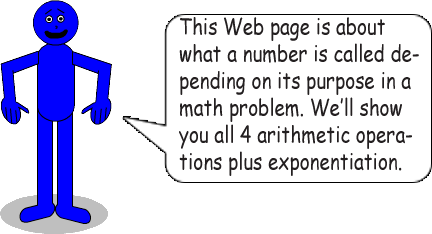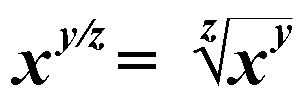The Names of Numbers in Math Problems

The variable A will represent the 1st number, B will represent the 2nd number & C will represent the 3rd number, which is the correct answer to the math problem.
Addition:
A + B = C
Both A & B are the addends & C is the sum or total.
Note: Sometimes, the 1st number is called the augend.
Subtraction:
A - B = C
A is the minuend, B is the subtrahend & C is the difference.
Multiplication:
A × B = C
A is the multiplicand, B is the multiplier & C is the product.
Note: You can also simply call both A & B factors!
Division:
A ÷ B = C
A is the dividend or numerator, B is the divisor or denominator & C is the quotient or fraction. (C is especially called a fraction if it isn't an integer!)
Note: If A is not evenly divisible by B, then there will also be a 4th number called the remainer!
Exponentiation:
A^B = AB = C
A is the base, B is the exponent & C is the power.
Note: When B is equal to a non-integer, consider radicals! Why? Because raising a number to the power of a non-integer, like ½, is the same as calculating the square root! It depends on what the numerator is or what the denominator is...

Okay, I'll give you a little hint about it:

Back to Index Page Back to Math Trick Menu
© Derek Cumberbatch



